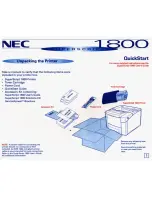
Repair information
Removal precautions
CAUTION—SHOCK HAZARD:
For personal safety and to prevent damage to the printer, remove the power cord
from the electrical outlet before you connect or disconnect any cable, electronic board or assembly.
Data security notice
1
This printer contains various types of memory that are capable of storing device and network settings, information
from embedded solutions, and user data. The types of memory, along with the types of data stored by each, are
described below.
•
Volatile memory
—This device utilizes standard Random Access Memory (RAM) to temporarily buffer user data
during simple print and copy jobs.
•
Non-volatile memory
—This device may utilize two forms of non-volatile memory: EEPROM and NAND (flash
memory). Both types are used to store the operating system, device settings, network information, scanner and
bookmark settings, and embedded solutions.
•
Hard disk memory
—Some devices have a hard disk drive installed. The printer hard disk is designed for device-
specific functionality and cannot be used for long term storage for data that is not print-related. The hard disk
does not provide the capability for users to extract information, create folders, create disk or network file shares,
or transfer FTP information directly from a client device. The hard disk can retain buffered user data from
complex print jobs, as well as form data and font data.
To erase volatile memory, turn off the printer.
To erase non-volatile memory, see the menu item under
“Configuration menu” on page 134
pertaining to this.
To erase the printer hard disk, see the menu item under
“Configuration menu” on page 134
pertaining to this.
The following parts are capable of storing memory:
•
printer control panel
•
UICC (User Interface Controller Card)
•
controller board
•
optional hard drives
Note:
The printer control panel and controller board contain NVRAM.
2
After removing the old part, it must be returned to your next level of support.
Handling ESD
‑
sensitive parts
Many electronic products use parts that are known to be sensitive to electrostatic discharge (ESD). To prevent damage
to ESD-sensitive parts, use the following instructions in addition to all the usual precautions, such as turning off power
before removing logic boards:
•
Keep the ESD-sensitive part in its original shipping container (a special “ESD bag”) until you are ready to install the
part into the machine.
•
Make the least-possible movements with your body to prevent an increase of static electricity from clothing fibers,
carpets, and furniture.
4514
Repair information
143
Summary of Contents for M1140
Page 18: ...4514 18 ...
Page 20: ...4514 20 ...
Page 142: ...4514 142 ...
Page 197: ...b Set the spring over the plunger 4514 Repair information 197 ...
Page 204: ...3 Squeeze the latches B to release the left and right links B 4514 Repair information 204 ...
Page 228: ...10 Remove the screw C and then detach the trailing edge sensor A 4514 Repair information 228 ...
Page 229: ...11 Disconnect the two springs D 4514 Repair information 229 ...
Page 246: ...3 Swing the right cover backward to remove 4 Remove the screw D 4514 Repair information 246 ...
Page 248: ...4514 248 ...
Page 253: ...4514 253 ...
Page 255: ...Assembly 1 Covers 4514 Parts catalog 255 ...
Page 257: ...Assembly 2 Electronics 1 4514 Parts catalog 257 ...
Page 259: ...Assembly 3 Electronics 2 4 3 2 1 6 5 4514 Parts catalog 259 ...
Page 261: ...4514 Parts catalog 261 ...
Page 262: ...Assembly 4 Frame 4514 Parts catalog 262 ...
Page 264: ...4514 Parts catalog 264 ...
Page 265: ...Assembly 5 Option trays 3 4 5 6 1 2 4514 Parts catalog 265 ...
Page 268: ...4514 Parts catalog 268 ...
Page 270: ...4514 270 ...
Page 274: ...4514 274 ...
Page 276: ...4514 276 ...
Page 298: ...4514 Part number index 298 ...
Page 302: ...4514 Part name index 302 ...
Page 303: ......
















































